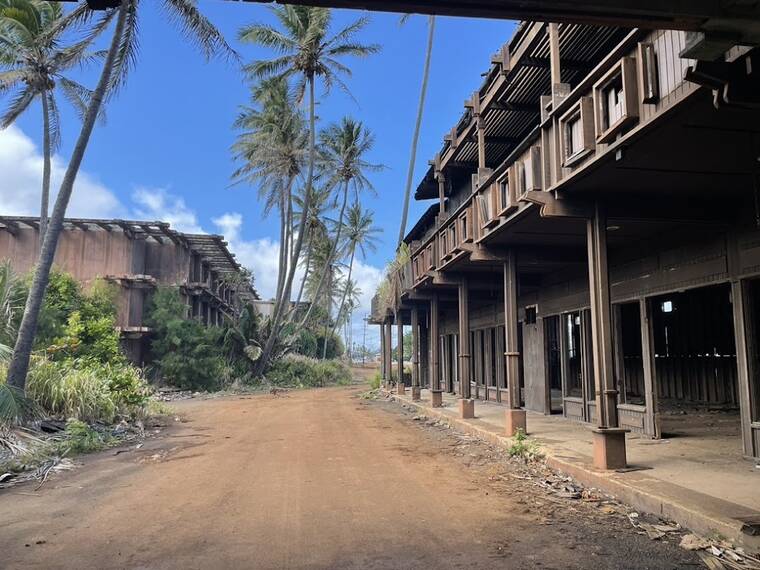KAPA‘A — As the plan to develop the ruins of Coco Palms into a 350-room hotel slowly creeps forward, a community group has proposed an alternative vision for the site.
In a meeting with the Garden Island, I Ola Wailuanui laid out an acquisition proposal in which they would purchase the site from current developers and build a Native Hawaiian cultural center in its place.
“There are many reasons that we don’t think a hotel is suitable there,” said Fern Anuenue Holland of I Ola Wailuanui. “So we’re reimagining the future of this place. Over the last two and a half years, we’ve thought of so many beautiful benefits that the community would gain from this site being turned into a cultural, educational, and historical center.”
The I Ola Wailuanua working group includes native Hawaiian researchers, local politicians, and historical experts, who have collaborated with various community organizations to develop the broad strokes of what this sort of project could include.
Among the features the group suggests are an amphitheater, a health center, a fishpond, a hub for cultural practitioners, Lonoikamakahiki (culture and games) and a living museum.
The plan would cost an estimated $53.4 million for acquisition, planning, demolition, restoration and stewardship, and would be completed by 2030.
Before the project crystalizes, more outreach is needed, Holland said.
“We need to bring a board of lineal descendants to the table and create and decide — how do we deal with these grave sites?” said Holland. “What gets restored, what ancient features do we protect, what’s appropriate for visitors, and what’s appropriate to build? It all needs to be shaped by the Hawaiian community.”
Proponents see this idea as a better way to acknowledge the historical significance of the area to Native Hawaiians. The resort sits on the site of ancient royal lands and burial grounds mapped in the Great Mahele, featuring the remains of heiaus (temples), a birthing stone and unique loko i‘a (fishponds).
I Ola Wailuanui also stresses the ecological importance of the area, both to mitigate flooding and as a habitat for endangered species.
The budget:
A proposed budget estimates the costs of various aspects of the project:
• $15-$18 million for the purchase of the property.
• $2.1 million to establish a nongovernmental organization and cover project management, legal and due diligence costs for three years.
• $2.7 million for community outreach, permitting, and various studies.
• $8 million for demolition and rehab.
• $17 million for the restoration of fishponds, gardens, wetland systems, and infrastructure.
• $1.6 million for staffing of a stewardship group.
• $4 million for stewardship and legal defense.
Financing for the project is still up in the air. The group has been approaching potential contributors in hopes of finding an anchor donor to fund a large chunk of the purchase.
Once completed, Holland said, the project might create opportunities for revenues through events, entertainment, museums, workshops, arts and crafts, and farm-to-table restaurants.
Whether the current development team, Utah-based RP21 Coco Palms LLC, will play ball on a sale is also unclear.
“We have no idea what the developer will accept, so that part is really hard to estimate,” said Holland.
Representatives of the property ownership said they would be willing to entertain offers on the site at a planning commission meeting earlier this month. But they also reiterated that they thought building a hotel was the best way to move forward.
“As it stands, we have the permits in place and we think the best way to move forward on what’s been a problem spot for the community is the development of a hotel that will bring revenue and jobs,” said Chad Decoursey, attorney for Reef Capital, a group involved in the financing of the project. It was purchased at auction for $22 million in 2021.
The alternate idea has community support, with a petition calling for the land to be protected from resort development garnering nearly 14,000 signatures and hundreds of people speaking in opposition to the proposed hotel development at recent planning commission meetings.
The ruins of the Coco Palms site itself have played host to this debate. Three separate times in the last few months, the phrase “Hawai‘i Is Not America,” has been painted on the side of the building in white block letters, before being painted over.



NO HOTEL! This sounds beautiful. Imagine what this hui has in mind and then think of some traffic-hogging hotel sitting there? Which one would you want to look at as you drive by? This is an opportunity to give Hawaiian Culture its day back in the sun. This should be a no-brainer. Let’s get it right.
This corner spot, on 2 of our most traveled roads, hopefully will be purchased from the existing owners. As far as all the suggested potential uses, almost none of them are suitable for this ancient site. A park with interpretive signs and no commercial activity would better serve the community. It needs to be in the most natural state possible.
I agree that a hotel would exacerbate the already-horrific traffic in the area. But, will the zoning change? Or will the county adjust the property tax rate?
Mahalo to council candidate FERN HOLLAND for Her time and effort getting the commitments out of so many wealthy people who are normally very difficult to contact or receive funds from.
If at least the Coco Palms property can be bought, and the destroyed hotel demolished it will produce at least a beautiful natural resource of a Natural Coco Palms Paradise, along with no more additional traffic congestion on Kuhio Hwy.
This relatively unknown woman, born and raised on Kauai, will get my vote for County Council.
We can see that we can expect great things and hard work from her as 1 of our council people.
I’m casting 1 of my votes for Fern Holland.
Mahalo, Fern for working so hard for us.